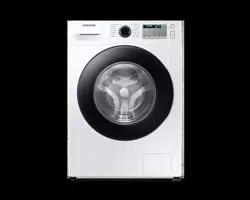Documents: Go to download!
- Owner's manual - (English)
- Installation
- Operations
- Settings
- Maintenance
- Troubleshooting
Table of contents
User Manual Washing Machine
Installation
Step-by-step installation
STEP 1 Select a location
Location requirements:
- Solid, level surface without carpeting or flooring that may obstruct ventilation
- Away from direct sunlight
- Adequate room for ventilation and wiring
- The ambient temperature is always higher than the freezing point (0 °C)
- Away from a heat source
STEP 2 Remove the shipping bolts
Unpack the product package and remove all shipping bolts.
NOTE
Number of shipping bolts may differ depending on the model.
WARNING
- Packaging materials can be dangerous to children. Dispose all packaging material (plastic bags, polystyrene, etc.) out of children’s reach.
- To avoid injury, cover the holes with bolt caps after removing the shipping bolts. Do not move the washing machine without the shipping bolts in place. Assemble the shipping bolts before moving the washing machine to another location. Keep the shipping bolts in a safe place for future use.
1. Locate the shipping bolts (marked with circle in the figure) on the rear side of the washing machine.
CAUTION
Do not remove the screw (A) that fixes the hose clip.
2. Using the supplied spanner, loosen all the shipping bolts by turning them counterclockwise.
NOTE
You must keep the shipping bolts for future use.

3. Insert the bolt caps (B) to the holes (marked with circle in the figure)

STEP 3 Adjust the levelling feet
1. Gently slide the washing machine into position.
Excessive force may damage the levelling feet.
2. Level the washing machine by manually adjusting the levelling feet.

3.When levelling is complete, tighten the nuts using the spanner.
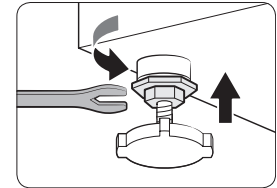
CAUTION
When installing the product make sure the levelling feet is not pressing the power cord.

STEP 4 Connect the water hose
The provided water hose may differ depending on the model. Please follow the instruction according to the provided water hose.
Connecting to a threaded water tap
1. Connect the water hose to the water tap, and then turn the connector clockwise as shown.
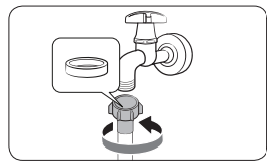
2.Connect the other end of the water hose to the inlet valve on the back of the washing machine. Turn the hose clockwise to tighten.

3. Open the water tap and check if there are any leaks around the connection areas. If there are water leaks, repeat the steps above.
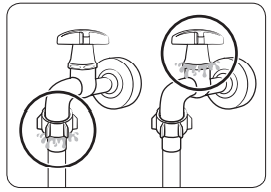
Connecting to a non-threaded water tap
1. Remove the adaptor (A) from the water hose (B).

2. Use a Phillips screwdriver to loosen four screws on the adaptor.
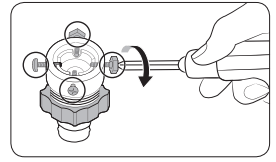
3. Hold the adaptor and turn part (C) in the arrow direction to loosen it by 5 mm (*).
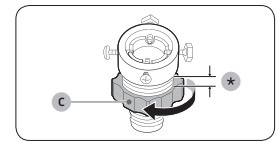
4. Insert the adaptor onto the water tap, and then tighten the screws while lifting the adaptor.
5. Turn part (C) in the arrow direction to tighten it.
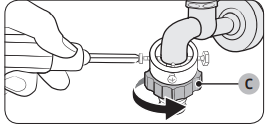
6. While pulling down part (D) on the water hose, connect the water hose to the adaptor. Then, release part (D). The hose fits into the adaptor with a clicking sound.
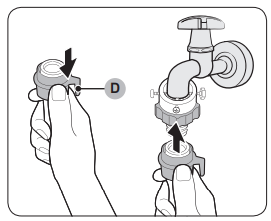
7. To complete connecting the water hose, see 2 and 3 on the “Connecting to a threaded water tap” section.
NOTE
- After connecting the water hose to the adaptor, check if it is connected properly by pulling the water hose downwards.
- Use a popular type of water taps. If the tap is square-shaped or too big, remove the spacer ring before inserting the tap into the adaptor.
For models with an additional hot water inlet:
1. Connect the red end of the hot water hose to the hot water inlet on the back of the machine.
2. Connect the other end of the hot water hose to the hot water tap.
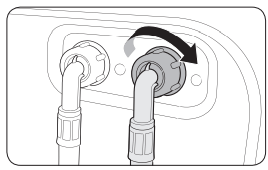
Aqua hose (applicable models only)
The aqua hose alerts users of a risk of water leaks.
It senses the water flow and turns red on the centre indicator (A) in case of a leak.
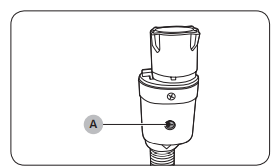
NOTE
The end of the aqua stop hose must be fitted to the water tap and not the machine.
STEP 5 Position the drain hose
The drain hose can be positioned in three ways:
Over the edge of a wash basin
The drain hose must be placed at a height of between 60 cm and 90 cm (*) from the floor. To keep the spout of the drain hose bent, use the supplied plastic hose guide (A). Secure the guide to the wall using a hook to ensure stable drainage.

In a drain pipe
The drain pipe should be between 60 cm and 90 cm high
(*). It is advisable to use a 65 cm high vertical pipe.
- To ensure the drain hose stays in position, use the plastic hose guide provided (see the figure).
- To prevent the siphoning of water flow during drainage, make sure to insert the drain hose 15 cm in the drain pipe.
- To prevent the drain hose from moving around, secure the hose guide to the wall.
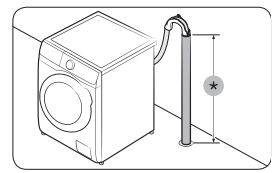
Drain standpipe requirements:
- Minimum diameter of 5 cm
- Minimum carry-away capacity of 60 litres per minute
In a sink drain pipe branch
The drain pipe branch mush be above the sink siphone so that the end of the hose is at least 60 cm above the ground.
(*) : 60 cm
CAUTION
Remove the lid on the sink drain pipe branch before connecting the drain pipe to it.

CAUTION
Do not put the drain hose in places of stagnant water or ponding. The water may flow back to the washing machine.
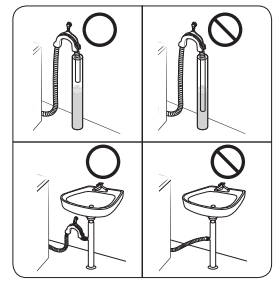
STEP 6 Power on
Plug the power cord into a wall socket featuring an AC 220-240 V / 50 Hz approved electrical outlet protected by a fuse or circuit breaker. Then, press Power to turn on the washing machine.
Operations
Control panel
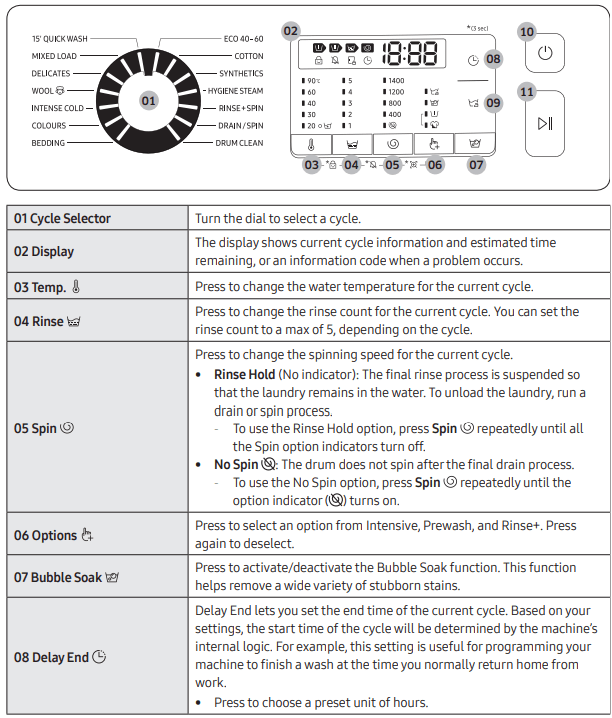

Simple steps to start

- Press Power to turn on the washing machine.
- Turn the Cycle Selector to select a cycle.
- Change the cycle settings (Temp
 , Rinse
, Rinse  , and Spin
, and Spin  ) as necessary.
) as necessary. - To add an option, press Options
 . Use the button again to choose a preferred item.
. Use the button again to choose a preferred item. - The machine provides the easy to access buttons for Bubble Soak
 , Delay End
, Delay End  and Easy Iron
and Easy Iron  for your convenience. If you want to use one of these options, press the corresponding button.
for your convenience. If you want to use one of these options, press the corresponding button. - Press Start/Pause.
To change the cycle during operation
- Press Start/Pause to stop operation.
- Select a different cycle.
- Press Start/Pause again to start the new cycle.
Cycle overview
Standard cycles


NOTE
- Loading the household washing machine or the household washer-dryer up to the capacity indicated by the manufacturer for the respective programmes will contribute to energy and water savings.
- The noise and remaining moisture content are influenced by the spinning speed: the higher the spinning speed in the spinning phase, the higher the noise and the lower the remaining moisture content.
- The most efficient cycle in terms of energy consumption are generally those that perform at lower temperatures and longer duration.
Options

Delay End 
You can set the washing machine to finish your wash automatically at a later time, choosing a delay of between 1 to 19 hours (in 1 hour increments). The hour displayed indicates the time the wash will finish.
- Select a cycle. Then change the cycle settings if necessary.
- Press Delay End
 repeatedly until a desired end time is set.
repeatedly until a desired end time is set. - Press Start/Pause. The corresponding indicator turns on with the clock running.
- To cancel the Delay End
 , restart the washing machine by pressing Power.
, restart the washing machine by pressing Power.
Real-life case
You want to finish a two-hour cycle 3 hours later from now. For this, you add the Delay End option to the current cycle with the 3-hour setting, and press Start/Pause at 2:00 p.m. Then, what happens? The washing machine starts operating at 3:00 p.m., and ends at 5:00 p.m. Provided below is the time line for this example.

Settings
Child Lock 
To prevent accidents by children, Child Lock locks all buttons except for Power.
- To set the Child Lock function, hold down Temp
 and Spin
and Spin  simultaneously for 3 seconds.
simultaneously for 3 seconds. - To release the Child Lock function, hold down Temp
 and Spin
and Spin  simultaneously for 3 seconds.
simultaneously for 3 seconds.
NOTE
- In the Child Lock state, you must first release the Child Lock if you want to add detergent or laundry.
- Your setting will be kept even after restarting the machine.
Sound On/Off -319291.png)
You can turn on or off the key. Your setting will remain effective after you restart the machine.
- To mute the sound, hold down Spin
 and Options
and Options  simultaneously for 3 seconds.
simultaneously for 3 seconds. - To unmute the sound, hold down again for 3 seconds.
Maintenance
Keep the washing machine clean to prevent deteriorated performance and to preserve its life cycle.
Drum clean
Perform this cycle regularly to clean the drum by removing bacteria from it. This cycle heats the water between 60 °C and 70 °C, and it also removes accumulated dirt from the rubber door gasket.
- Press Power to turn on the washing machine.
- Turn the Cycle Selector to select DRUM CLEAN.
- Press and hold Start/Pause.
NOTE
- The water temperature for DRUM CLEAN is set to 70 °C, which cannot be changed.
- It is recommended to run the DRUM CLEAN cycle once every 40 washes.
- To prevent limescale, add the proper amount of detergent according to your local water hardness or add a water softener additive together with the detergent.
DRUM CLEAN reminder
Depending on the model, the DRUM CLEAN reminder is either an icon or an LED.
For icons, the icon lights up on the control panel.
For LEDs, the LED lights up next to DRUM CLEAN, or on the option area of the control panel.
- The DRUM CLEAN reminder blinks on the control panel once every 40 washes. It is advisable to perform DRUM CLEAN regularly.
- When you first see this reminder blinking, you can ignore the reminder for 6 consecutive washes. From the 7th wash, the reminder no longer appears. However, it appears again on the second 40th wash.
- Even after the last process is terminated, the "0" message may remain.
- You can record the running count of the DRUM CLEAN cycle by pressing the Power button. This does not stop or turn off the machine but marks your cycle count.
- Even if "0" does not disappear, the machine operates normally.
- It is recommended to run the cycle regularly for hygienic purposes
Smart Check 
To enable this function, you must first download the Samsung Smart Washer app at the Play Store or the App Store, and install it on a mobile device featuring a camera function.
The Smart Check function has been optimised for Galaxy & iPhone series (applicable models only).
- When the washing machine detects an issue to check, an information code appears on the display. To enter Smart Check mode, press and hold Options
 and Delay End simultaneously for 3 seconds.
and Delay End simultaneously for 3 seconds. - The washing machine starts the self-diagnosis procedure and displays an information code if a problem is detected.
- Run the Samsung Smart Washer app on your mobile device, and tap Smart Check.
- Put the mobile device close to the washing machine’s display so that the smartphone camera and the washing machine face each other. Then, the information code will be recognised automatically by the app.
- When the information code is recognised correctly, the app provides detailed information about the problem with applicable solutions.
NOTE
- The function name, Smart Check, may differ depending on the language.
- If the washing machine reflects light on the display, the app may fail to recognise the information code.
- If the app fails to recognise the Smart Check code consecutively, enter the information code manually onto the app screen.
Emergency drain
In case of a power failure, drain the water inside the drum before taking out the laundry.
1. Power off and unplug the washing machine from the electrical outlet.
2. Gently press the top area of the filter cover (A) to open.

3. Put an empty, spacious container around the cover, and stretch the emergency drain tube to the container while holding the tube cap (B).
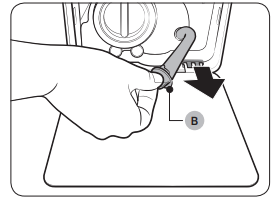
4. Open the tube cap and let water in the emergency drain tube (C) flow into the container.
5. When done, close the tube cap, and reinsert the tube. Then, close the filter cover.
NOTE
Use a spacious container because the water in the drum may be more than expected.

Cleaning
Surface of the washing machine
Use a soft cloth with a nonabrasive household detergent. Do not spray water onto the washing machine.
Mesh filter
Clean the mesh filter of the water hose once or twice a year.
1. Turn off the washing machine, and unplug the power cord.
2.Close the water tap.
3 .Loosen and disconnect the water hose from the back of the washing machine. Cover the hose with a cloth to prevent water from gushing out.
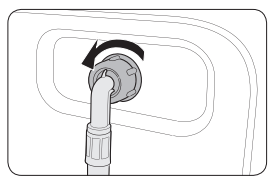
4. Use pliers to pull out the mesh filter from the inlet valve.
5. Submerge the mesh filter deeply in water so that the threaded connector is also submerged.
6. Dry the mesh filter completely in the shade.
7. Reinsert the mesh filter into the inlet valve, and reconnect the water hose to the inlet valve.
8. Open the water tap.
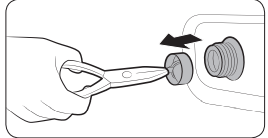
Debris filter
Clean the debris filter bi-monthly to prevent clogging. A clogged debris filter may reduce the bubble effect.
1. Turn off the washing machine, and unplug the power cord.
2. Drain the remaining water inside the drum. See the “Emergency drain” section.
3. Gently press the top area of the filter cover to open.
4. Turn the debris filter knob to the left, and drain off the remaining water.

5. Clean the debris filter using soft brushes. Make sure the drain pump propeller inside the filter is unclogged.
6. Reinsert the debris filter, and turn the filter knob to the right.
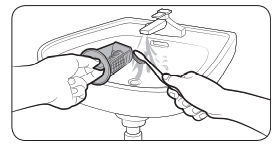
NOTE
- Some debris filters feature a safety knob that is designed to prevent accidents by children. To open the safety knob of the debris filter, push in and turn it anticlockwise. The spring mechanism of the safety knob helps open the filter.
- To close the safety knob of the debris filter, turn it clockwise. The spring makes a rattling sound, which is normal.
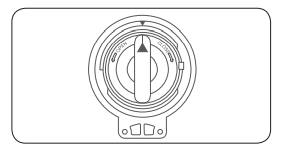
Detergent drawer
1. While holding down the release lever (A) on the inner of the drawer, slide open the drawer.
2. Remove the release lever and the liquid detergent guide from the drawer.
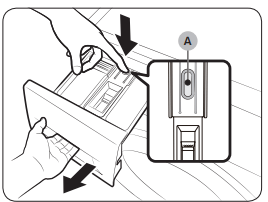
3. Clean the drawer components in flowing water using a soft brush.
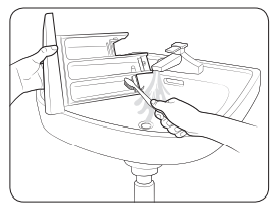
4. Clean the drawer recess using a bottle brush to remove detergent residues and limescale on the drawer recess.
5. Reinsert the release lever and the liquid detergent guide to the drawer.
6. Slide the drawer inward to close it.
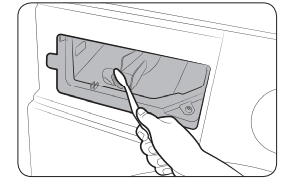
Recovery from freezing
The washing machine may freeze when it drops below 0 °C.
- Turn off the washing machine, and unplug the power cord.
- Pour warm water over the water tap to loosen the water hose.
- Disconnect the water hose, and soak it in warm water.
- Pour warm water into the drum and leave it for about 10 minutes.
- Reconnect the water hose to the water tap.
NOTE
If the washing machine still doesn’t operate normally, repeat the above steps until it operates normally.
Care against an extended time of disuse
Avoid leaving the washing machine unused for an extended time. If this is the case, drain the washing machine and unplug the power cord.
- Turn the Cycle Selector to select a RINSE+SPIN.
- Empty the drum, and press Start/Pause.
- When the cycle is complete, close the water tap and disconnect the water hose.
- Turn off the washing machine, and unplug the power cord.
- Open the door to let air circulate through the drum.
Troubleshooting
Checkpoints
If you encounter a problem with the washing machine, first check the table below and try the suggestions.
Does not start.
- Make sure the washing machine is plugged in.
- Make sure the door is properly closed.
- Make sure the water taps are open.
- Make sure to press or tap Start/Pause to start the washing machine.
- Make sure Child Lock
 is not activated.
is not activated. - Before the washing machine starts to fill, it will make a series of clicking noises to check the door lock and does a quick drain.
- Check the fuse or reset the circuit breaker.
Water supply is insufficient, or no water is supplied.
- Fully open the water tap.
- Make sure the door is properly closed.
- Make sure the water supply hose is not frozen.
- Make sure the water supply hose is not kinked or clogged.
- Make sure there is sufficient water pressure.
After a cycle, detergent remains in the detergent drawer.
- Make sure the washing machine is running with sufficient water pressure.
- Make sure the detergent is added to the centre of the detergent drawer.
- Make sure the rinse cap is inserted properly.
- If using granular detergent, make sure the detergent selector is in the upper position.
- Remove the rinse cap and clean the detergent drawer.
Excessive vibrations or makes noise.
- Make sure the washing machine is installed on a level, solid floor that is not slippery. If the floor is not level, use the levelling feet to adjust the height of the washing machine.
- Make sure the shipping bolts are removed.
- Make sure the washing machine is not contacting any other object.
- Make sure the laundry load is balanced.
- The motor can cause noise during normal operation.
- Overalls or metal-decorated clothes can cause noise while being washed. This is normal.
- Metal objects such as coins can cause noise. After washing, remove these objects from the drum or filter case.
Does not drain and/ or spin.
- Make sure the drain hose is straightened all the way to the drain system. If you encounter a drain restriction, call for service.
- Make sure the debris filter is not clogged.
- Close the door and press or tap Start/Pause. For your safety, the washing machine will not tumble or spin unless the door is closed.
- Make sure the drain hose is not frozen or clogged.
- Make sure the drain hose is connected to a drain system that is not clogged.
- If the washing machine is not supplied with sufficient power, the washing machine temporarily will not drain or spin. As soon as the washing machine regains sufficient power, it will operate normally.
Spinning does not work.
- Make sure laundry is spread out evenly.
- Make sure the washing machine is on a flat, stable surface.
- Redistribute the load. If only one item of clothing needs washing, such as a bathrobe or pair of jeans, the final spin result might be unsatisfactory, and an “Ub” check message will be shown in the display.
The door does not open.
- Press or tap Start/Pause to stop the washing machine.
- It may take a few moments for the door lock mechanism to disengage.
- The door will not open until 3 minutes after the washing machine has stopped or the power turned off.
- Make sure all the water in the drum is drained.
- The door may not open if water remains in the drum. Drain the drum and open the door manually.
- Make sure the door lock light is off. The door lock light turns off after the washing machine has drained.
Excessive suds.
- Make sure you use the recommended types of detergent as appropriate.
- Use high efficiency (HE) detergent to prevent oversudsing.
- Reduce the detergent amount for soft water, small loads, or lightly soiled loads.
- Non-HE detergent is not recommended.
Cannot apply additional detergent.
- Make sure the remaining amount of detergent and fabric softener is not over the limit.
Stops.
- Plug the power cord into a live electrical outlet.
- Check the fuse or reset the circuit breaker.
- Close the door and press the Start/Pause button to start the washing machine. For your safety, the washing machine will not tumble or spin unless the door is closed.
- Before the washing machine starts to fill, it will make a series of clicking noises to check the door lock and does a quick drain.
- There may be a pause or soak period in the cycle. Wait briefly and the washing machine may start.
- Make sure the mesh filter of the water supply hose at the water taps are not clogged. Periodically clean the mesh filter.
- If the washing machine is not supplied with sufficient power, the washing machine temporarily will not drain or spin. As soon as the washing machine regains sufficient power, it will operate normally.
Fills with the wrong water temperature.
- Fully open both taps.
- Make sure the temperature selection is correct.
- Make sure the hoses are connected to the correct taps. Flush water lines.
- Make sure the water heater is set to supply a minimum 120 °F (49 °C) hot water at the tap. Also, check the water heater capacity and recovery rate.
- Disconnect the hoses and clean the mesh filter. The mesh filter may be clogged.
- While the washing machine fills, the water temperature may change as the automatic temperature control feature checks incoming water temperature. This is normal.
- While the washing machine fills, you may notice just hot and/or just cold water going through the dispenser when cold or warm temperatures are selected. This is a normal function of the automatic temperature control feature as the washing machine determines the water temperature.
Load is wet at the end of a cycle.
- Use the High or Extra High spin speed.
- Use high efficiency (HE) detergent to reduce oversudsing.
- Load is too small. Small loads (one or two items) may become unbalanced and not spin completely.
- Make sure the drain hose is not kinked or clogged.
Leaks water.
- Make sure the door is properly closed.
- Make sure all hose connections are tight.
- Make sure the end of the drain hose is correctly inserted and secured to the drain system.
- Avoid overloading.
- Use high efficiency (HE) detergent to prevent oversudsing.
Has odours.
- Excessive suds collect in recesses and can cause foul odours.
- Run cleansing cycles to sanitize periodically.
- Clean the door seal (diaphragm).
- Dry the washing machine interior after a cycle has finished.
No bubbles are seen (Bubbleshot models only).
- Overloading may screen bubbles.
- Severely contaminated laundry may not generate bubbles.
Information codes
The washer may display information codes to help you understand what is occurring with your washer better.
Code - 4C
Water is not supplied.
- Make sure the water taps are open.
- Make sure the water hoses are not clogged.
- Make sure the water taps are not frozen.
- Make sure the washing machine is operating with sufficient water pressure.
- Make sure that the cold water tap and the hot water tap are properly connected.
- Clean the mesh filter as it may be clogged.
- When the washer displays “4C”, the washer do draining for 3 minutes. During this time, the Power button is inoperative.
Code - 4C2
- Make sure the cold water supply hose is firmly connected to the cold water tap.
If it is connected to the hot water tap, the laundry may be deformed with some cycles.
Code - 5C
Water is not draining.
- Make sure the drain hose is not frozen or clogged.
- Make sure the drain hose is positioned correctly, depending on the connection type.
- Clean the debris filter as it may be clogged.
- Make sure the drain hose is straightened all the way to the drain system.
- If the information code remains, contact a customer service centre.
Code - dC
Operating the washing machine with the door open.
- Make sure the door is properly closed.
- Make sure laundry is not caught in the door.
Code - OC
Water is overflowed.
- Restart after spinning.
- If the information code remains on the display, contact a local Samsung service centre.
Code - LC,LC1
Check the drain hose.
- Make sure the end of the drain hose is not placed on the floor.
- Make sure the drain hose is not clogged.
- If the information code remains, contact a customer service centre.
Code - 3C
Check the motor for operation.
- Try restarting the cycle.
- If the information code remains, contact a customer service centre.
Code - UC
The electronic control needs to be checked.
- Check if power is supplied properly.
- If the information code remains, contact a customer service centre.
Low voltage detected.
- Check if the power cord is plugged in.
- If the information code remains, contact a customer service centre.
Code - HC
High temperature heating check.
- If the information code remains, contact a customer service centre.
Code - 1C
The Water Level sensor is not working properly.
- Try power off and restarting the cycle.
- If the information code remains, contact a customer service centre.
Code - AC
Check communications between main and sub PBAs.
- Try power off and restarting the cycle.
- If the information code remains, contact a customer service centre.
Code - 0
The machine does not turn off automatically after the last spinning process, and the "0" message remains.
- The machine operates normally without running the DRUM CLEAN cycle. However, it is recommended to run the cycle for hygienic purposes.
See other models: WW80T554DAW/S1 SM-R180NZRAXAR SM-A516UZKZAIO SM-R220NZKAXAR WF45T6000AV/A5
